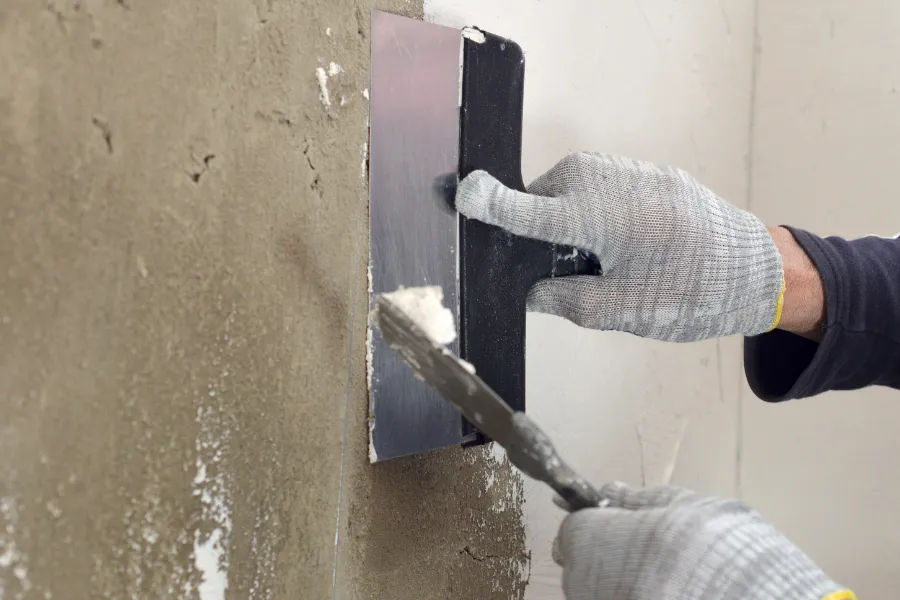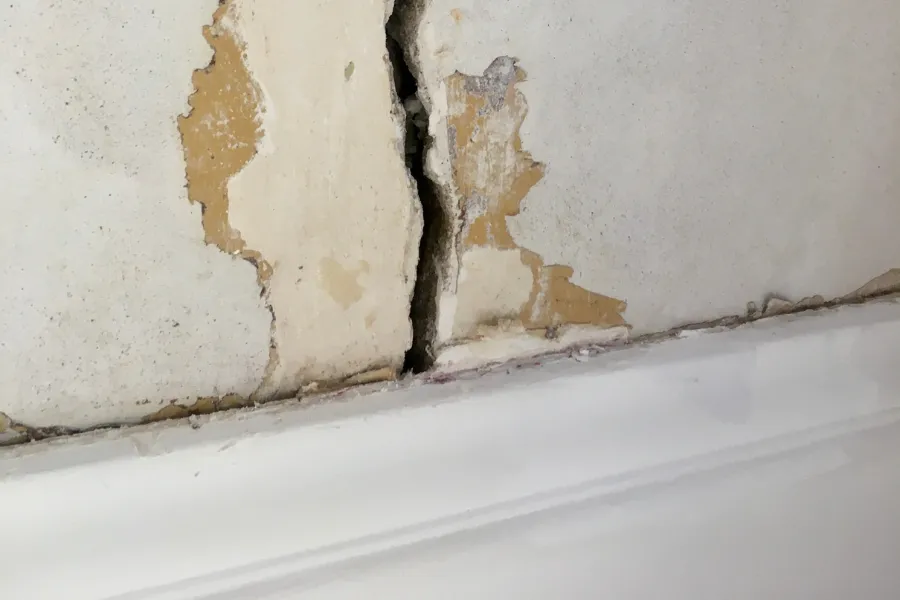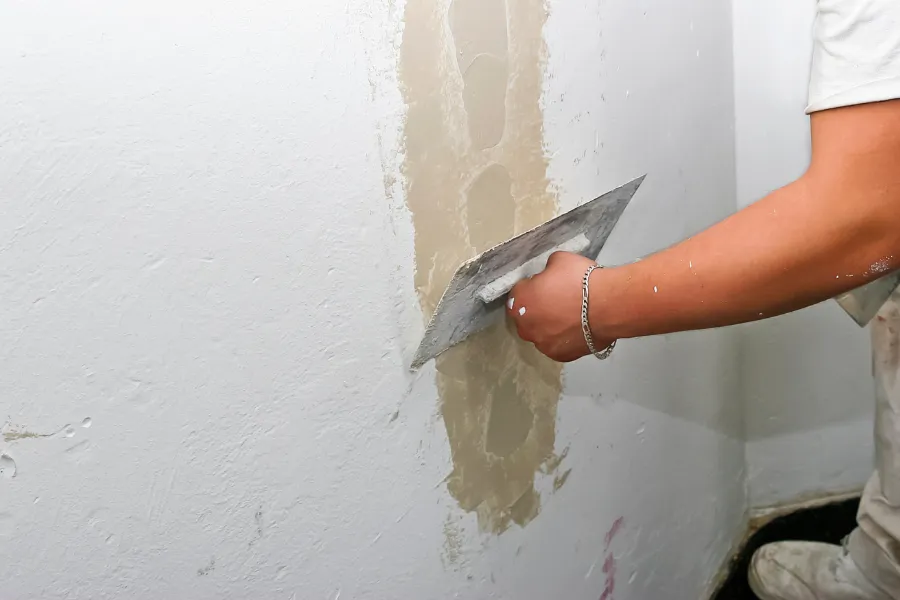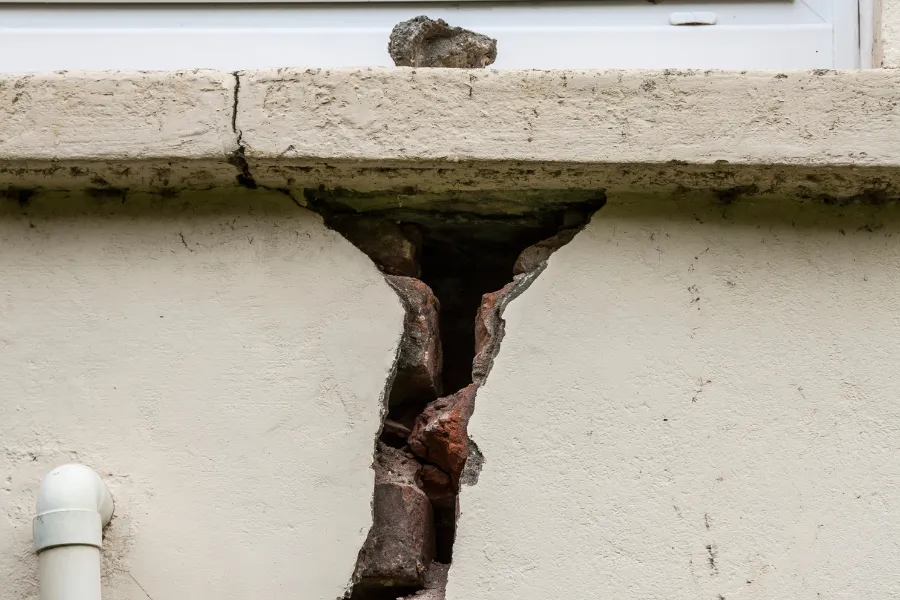Foundation cracks are one of the most common and concerning problems homeowners face. Whether it starts as a thin line in the basement wall or a large diagonal crack across a foundation corner, it raises immediate questions: Is this normal? What caused it? How bad can it get?
Cracks in your foundation aren’t always serious, but some are signs of real structural problems that can lead to costly repairs if ignored. Understanding what causes foundation cracks and knowing how to fix them can save you thousands and help protect your home from long-term damage. At Diamond Waterproofing & Masonry, we’ve repaired every type of crack you can imagine, and we’re breaking down the ten most common causes we have seen.
Factors that Cause Foundation Cracks and the Repair Process
1. Soil Movement and Foundation Settlement
One of the leading causes of foundation cracks is soil movement beneath the home. Over time, soil naturally shifts due to changes in moisture, gravity, and compaction. In many areas of Long Island, clay-rich soil expands when wet and shrinks when dry. This constant shifting creates pressure points under your home, eventually leading to vertical or diagonal cracks in the foundation walls or slab.
In newly built homes, minor settling cracks can be expected within the first few years. However, continued settlement or uneven shifting is a red flag.
How to fix it:
Soil stabilization, re-grading the yard, and installing perimeter drainage systems can relieve pressure and prevent further movement. In severe cases, structural support such as underpinning or helical piers may be needed. If you’re noticing signs of uneven settling or visible cracks, it may be time to consider a professional solution. Explore our foundation crack repair services to prevent further damage and restore stability.

2. Hydrostatic Pressure from Poor Drainage
When water collects around your foundation after rain or snowmelt, it doesn’t just sit there, it presses against the foundation walls. This is called hydrostatic pressure, and over time it causes walls to bow inward or crack horizontally. It’s especially common in basements that haven’t been waterproofed or don’t have proper drainage systems.
Water-related foundation cracks are more than just structural problems, they can lead to mold, mildew, and indoor air quality issues that affect your entire home.
How to fix it:
- Install or upgrade a French drain or interior drainage system to reduce pressure.
- Waterproof foundation walls with membrane coatings or sealants, and keep gutters clean and downspouts extended at least 6 feet away from the home.
3. Poor Concrete Mix or Construction Mistakes
If your home’s foundation was built with weak concrete, low-quality materials, or poor construction practices, it’s more likely to crack, sometimes sooner rather than later. Inadequate curing time, minimal reinforcement, or improper grading during the build can all lead to cracking years down the line.
This is especially true for homes built during building booms or flipped properties, where speed was prioritized over quality.
How to fix it:
Foundation cracks caused by poor materials often need reinforcement, not just surface sealing. Depending on the condition, options include carbon fiber straps, epoxy injections, or rebuilding affected wall sections. A professional inspection is key to understanding the full scope.
4. Tree Roots Growing Too Close to the Foundation
Large trees planted too close to the home are a surprisingly common source of foundation cracks. Roots can grow under your foundation in search of moisture, disturbing the soil, displacing pressure, and sometimes pushing directly against concrete. As they grow, they create uneven support beneath your foundation.
Cracks from root intrusion typically appear on one side of the home and may accompany signs like uneven flooring or gaps in windows and doors.
How to fix it:
Root barriers can be installed underground to redirect root growth. In some cases, the tree may need to be removed entirely. Once roots are dealt with, foundation cracks should be sealed, and the soil re-compacted or stabilized to restore balance.
5. Seasonal Foundation Damage from Freeze-Thaw Cycles
Homes in Long Island are no stranger to harsh winters and hot summers. These seasonal temperature changes affect both the soil and the foundation. During winter, moisture in the soil freezes and expands, placing upward pressure on the foundation. When it thaws, it settles again. This constant shifting can lead to small foundation cracks that worsen over time.
The most obvious sign is cracks that open up in the winter or after heavy snow, followed by a thaw.
How to fix it:
- Maintain consistent soil moisture around your foundation to reduce dramatic shifts.
- Insulate basement walls to minimize interior temperature swings.
- Monitor cracks seasonally and seal any that begin to grow or leak.

6. Plumbing Leaks Below or Near the Foundation
Underground plumbing leaks are silent culprits. A small leak in a supply line or drain pipe beneath the slab can soften the soil under one part of the foundation, causing it to sink and crack. These types of cracks may show up suddenly and grow quickly.
Often, these leaks go unnoticed until water damage, a musty smell, or an uneven floor appears.
How to fix it:
A leak detection test can locate hidden plumbing problems. After repairs, voids in the soil should be filled or stabilized, and foundation cracks should be professionally sealed to prevent further movement or water intrusion.
7. Earthquakes or Nearby Construction Vibration
While Long Island isn’t known for major earthquakes, small tremors or nearby construction activity can send vibrations through the ground strong enough to crack older or poorly reinforced foundations. These types of cracks are often jagged, wide, and show up quickly.
They may be accompanied by small gaps around windows and doors or visible movement in the structure.
How to fix it:
A structural inspection can determine if reinforcement is necessary. Depending on severity, options may include wall anchors, steel braces, or epoxy crack repair for stabilization.
8. Poor Drainage and Improper Grading
Improper slope around the home causes rainwater to drain toward the foundation instead of away from it. This allows water to pool at the base of the foundation, increasing the risk of hydrostatic pressure, saturation, and soil movement. Over time, this leads to foundation cracks and basement leaks.
In many older homes, the grading has shifted over time, or landscaping was installed without proper drainage planning.
How to fix it:
- Regrade soil to slope away from the house.
- Extend downspouts and consider installing catch basins or exterior drainage systems.
- Foundation cracks caused by moisture pressure should be sealed and waterproofed to prevent recurrence.
9. Overwatering or Poor Landscaping Practices
Even well-intentioned landscaping can backfire if it causes excessive water near your foundation. Constant watering, improperly placed planters, or irrigation systems too close to the house can keep soil saturated and soft, reducing its ability to support the structure.
Signs include cracks near flower beds or wet soil against foundation walls, even during dry spells.
How to fix it:
- Adjust sprinkler systems, reroute drip lines, and keep plants at least 12–18 inches away from the foundation.
- Replace water-intensive landscaping with low-maintenance alternatives and reseal any foundation cracks caused by moisture damage.
10. Aging Concrete and Natural Deterioration
Like anything else, concrete ages. As it does, it becomes more brittle, less flexible, and more prone to cracking, especially in homes built 40+ years ago. Exposure to water, freeze-thaw cycles, and air over time slowly break down the materials.
Hairline cracks that slowly spread, surface flaking, and uneven coloring are all signs of aging concrete.
How to fix it:
- Foundation repair may involve resurfacing, reinforcing, or sealing.
- Long-term, a full foundation waterproofing system may be necessary to extend the life of the concrete and prevent deeper issues.

10 Causes of Foundation Cracks and How to Fix Them
| Cause | Crack Type | Common Location | Recommended Fix |
| Soil Movement | Vertical/Stair-step | Walls/Floor Corners | Drainage, soil stabilization |
| Hydrostatic Pressure | Horizontal | Basement walls | Waterproofing, French drain |
| Poor Construction | Wide, irregular | Anywhere | Carbon fiber, reinforcement |
| Tree Roots | Diagonal/Vertical | One wall or side | Root barriers, recompact soil |
| Seasonal Shifting | Hairline/Recurring | Corners or junctions | Insulation, seal and monitor |
| Plumbing Leaks | Sinking/sloping cracks | Near plumbing lines | Leak repair, slab stabilization |
| Vibrations/Quakes | Jagged/wide | Random walls or floor | Epoxy injection, wall anchors |
| Poor Drainage | Wet wall cracks | Lower foundation walls | Regrading, extend downspouts |
| Overwatering | Surface-level cracks | Near planters/beds | Irrigation control, sealing |
| Aging Materials | Flaking/Hairline | Full foundation | Waterproofing, reinforcement |
How to Know If Foundation Cracks Are Harmful To Your Home
Not all cracks are a reason to panic, but some definitely are. Here’s a quick guide to help you assess whether your foundation issue needs urgent attention:
- Less than 1/8 inch and not growing? Monitor and seal
- Wider than 1/4 inch or growing? Professional evaluation needed
- Diagonal or stair-step? Often a sign of settling
- Horizontal crack? Serious structural stress
- Water leaking through? Needs sealing and waterproofing immediately
If you’re not sure what type of crack you have, don’t guess. A quick visit from our team can give you peace of mind or catch a serious issue early.
The Best Time to Fix Foundation Cracks
Timing matters. The best seasons to inspect and repair foundation cracks are spring and fall, when the ground is stable and weather conditions are ideal for waterproofing and structural repair. At Diamond Waterproofing & Masonry, we recommend seasonal inspections to stay ahead of costly damage.
Need Professional Help Repairing Foundation Cracks?
We’ve helped hundreds of homeowners protect their homes from foundation failure. Whether you’re dealing with a brand-new crack or one that’s been creeping wider every season, we’ve got the tools, the experience, and the right solution.
Explore our foundation crack repair services to see how we fix problems at the source, not just the surface. Reach out for a professional foundation inspection, and let’s stop those cracks before they turn into a major repair. Your home’s safety depends on it.
